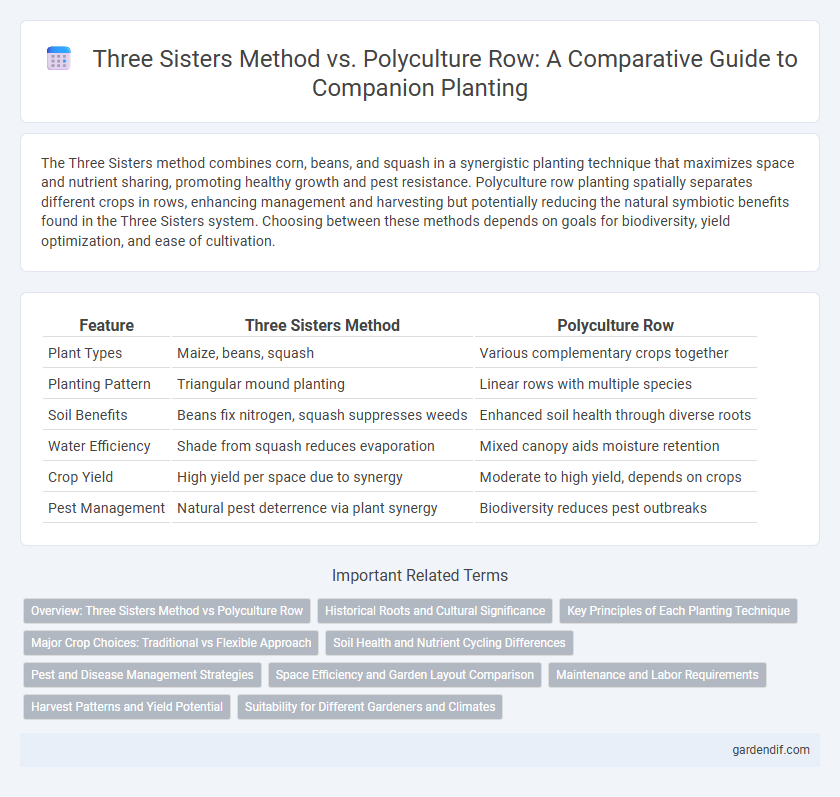
Three Sisters method vs polyculture row Illustration
The Three Sisters method combines corn, beans, and squash in a synergistic planting technique that maximizes space and nutrient sharing, promoting healthy growth and pest resistance. Polyculture row planting spatially separates different crops in rows, enhancing management and harvesting but potentially reducing the natural symbiotic benefits found in the Three Sisters system. Choosing between these methods depends on goals for biodiversity, yield optimization, and ease of cultivation.
Table of Comparison
| Feature | Three Sisters Method | Polyculture Row |
|---|---|---|
| Plant Types | Maize, beans, squash | Various complementary crops together |
| Planting Pattern | Triangular mound planting | Linear rows with multiple species |
| Soil Benefits | Beans fix nitrogen, squash suppresses weeds | Enhanced soil health through diverse roots |
| Water Efficiency | Shade from squash reduces evaporation | Mixed canopy aids moisture retention |
| Crop Yield | High yield per space due to synergy | Moderate to high yield, depends on crops |
| Pest Management | Natural pest deterrence via plant synergy | Biodiversity reduces pest outbreaks |
Overview: Three Sisters Method vs Polyculture Row
The Three Sisters method integrates corn, beans, and squash in a synergistic planting system, enhancing soil fertility and maximizing space through complementary plant relationships. Polyculture row planting involves arranging multiple crop species in rows, promoting biodiversity and pest control while maintaining easier access for cultivation and harvesting. Both methods support sustainable agriculture but differ in spatial design and interaction intensity among plant species.
Historical Roots and Cultural Significance
The Three Sisters method, deeply rooted in Native American agricultural traditions, involves the interplanting of corn, beans, and squash to enhance soil fertility and crop yield through natural symbiosis. In contrast, polyculture rows typically refer to modern planting techniques that combine multiple crops in a single row to optimize space and pest resistance, often lacking the profound cultural symbolism inherent in the Three Sisters. The Three Sisters not only represent a sustainable farming practice but also embody a spiritual connection and communal values central to Indigenous cultures across North America.
Key Principles of Each Planting Technique
The Three Sisters method integrates corn, beans, and squash in a symbiotic planting system where corn provides a support structure for climbing beans, beans fix nitrogen to enrich the soil, and squash offers ground cover to retain moisture and suppress weeds. Polyculture row planting arranges multiple crop species in alternating rows to enhance biodiversity, optimize space, and reduce pest pressure through companion planting and varied rooting depths. Both techniques emphasize natural cooperation among plants, nutrient cycling, and maximizing resource use for sustainable agriculture.
Major Crop Choices: Traditional vs Flexible Approach
The Three Sisters method emphasizes traditional major crops--corn, beans, and squash--planted together for mutual benefits and soil health. Polyculture row systems allow more flexible crop choices, integrating a wider variety of species tailored to specific environments or goals. This adaptability supports biodiversity and can improve resilience compared to the fixed crop trio of the Three Sisters.
Soil Health and Nutrient Cycling Differences
The Three Sisters method promotes soil health by combining corn, beans, and squash that mutually support nutrient cycling through nitrogen fixation by beans and ground cover provided by squash, enhancing moisture retention and reducing erosion. Polyculture row planting, while diverse, often spaces crops farther apart, limiting root intermingling and slowing efficient nutrient exchange between species. This results in the Three Sisters method fostering a more dynamic, self-sustaining soil ecosystem that optimizes nutrient availability and soil structure compared to traditional polyculture rows.
Pest and Disease Management Strategies
The Three Sisters method leverages the symbiotic planting of corn, beans, and squash to naturally reduce pest populations by creating a diverse microhabitat that disrupts pest life cycles. Polyculture rows also enhance pest and disease management by intercropping multiple species, increasing biodiversity, and minimizing monoculture vulnerabilities that pests and pathogens typically exploit. Both strategies reduce reliance on chemical pesticides, supporting sustainable agriculture through ecological balance and improved resilience against pests and diseases.
Space Efficiency and Garden Layout Comparison
The Three Sisters method maximizes space efficiency through vertical layering, combining corn, beans, and squash in a compact, mutually supportive planting that optimizes sunlight and soil nutrients. Polyculture row planting spreads different crops in separate rows, requiring more land area and less intensive vertical use but allowing easier access for maintenance and harvesting. Comparing garden layouts, the Three Sisters method creates a dense, integrated plot ideal for small spaces, while polyculture rows suit larger gardens where crop rotation and pest control benefit from spatial separation.
Maintenance and Labor Requirements
The Three Sisters method, integrating corn, beans, and squash in a traditional polyculture system, requires moderate maintenance with synchronized planting and mutual plant support reducing weeding needs. Polyculture row systems involve distinct, separately maintained crop rows which often demand higher labor input for individual row care, pest control, and irrigation management. Maintenance efficiency in the Three Sisters method benefits from natural plant interactions that promote soil health and reduce labor intensity compared to conventional polyculture rows.
Harvest Patterns and Yield Potential
The Three Sisters method, combining maize, beans, and squash in close proximity, promotes staggered harvest patterns with maize harvested first, beans next for fresh and dry harvests, and squash last for prolonged storage, optimizing resource use and labor distribution. Polyculture row planting, while also intercropping multiple species, allows for more flexible spacing and can lead to simultaneous or overlapping harvests, which may increase total yield but demand more intensive management. Yield potential in the Three Sisters is enhanced by symbiotic plant relationships improving soil fertility and moisture retention, whereas polyculture rows rely on strategic species selection and spacing to maximize crop output per unit area.
Suitability for Different Gardeners and Climates
The Three Sisters method, combining corn, beans, and squash, suits gardeners seeking a traditional, low-maintenance polyculture ideal for temperate climates with moderate rainfall. Polyculture row planting offers flexibility for diverse plant species and adapts well to varying garden sizes and microclimates, benefiting gardeners with limited space or those in warmer, drier regions. Each approach optimizes resource use differently, making the Three Sisters best for those embracing indigenous practices and polyculture rows preferable for customized crop combinations across varied environments.
Three Sisters method vs polyculture row Infographic

 gardendif.com
gardendif.com